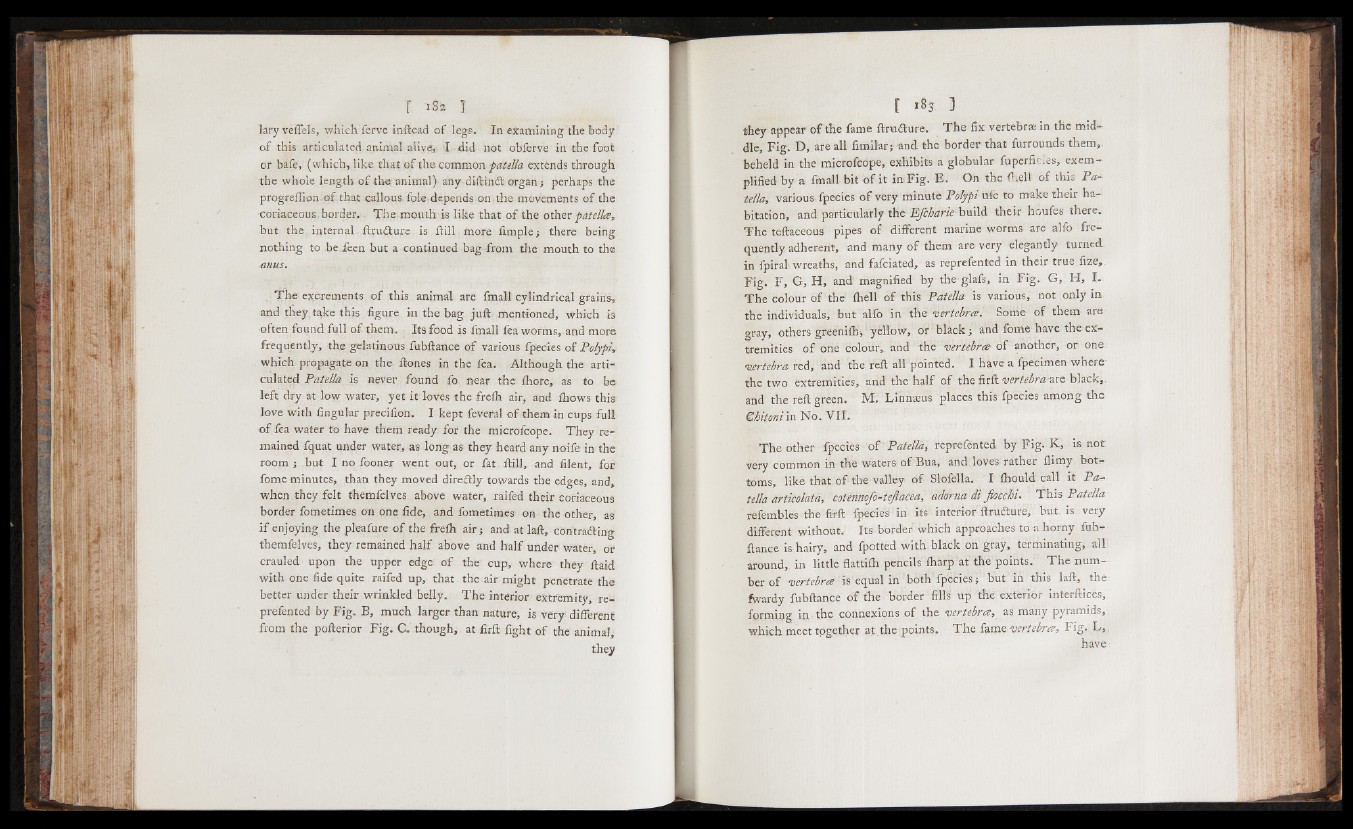
lary veffels, which ferve inftead o f legs. In examining the body
of this articulated animal alive, I did not obferve in the foot
or bafe, (which, like that o f the common patella extènds through
the whole length o f the animal) any diftintt organ ; perhaps the
progreffionof that callous foie depends on. the movements o f the
coriaceous border. The mouth is like that of the other patella,
but the internal ftrutture is ftill more fimple ; there being
nothing to be feen but a continued bag from the mouth to the
•anus.
The excrements o f this animal are fmall cylindrical grains,
and they take this figure in the bag juft mentioned, which is
often found full o f them. Its food is fmall fea worms, and more
frequently, the gelatinous fubftance o f various fpecies of Polypi,
which propagate on the ftones in the fea. Although the articulated
Patella is never found fo near the fhore, as to be
left dry at low water, yet it loves the frefh air, and fhows this
love with Angular precifion. I kept fever a 1 o f them in cups full
o f fea water to have them ready for the microfcope. They remained
fquat under water, as long as they heard any noife in the
room ; but I no fooner went out, or fat ftill, and filent, for
fome minutes, than they moved direttly towards the edges, and,
when they felt themfelves above water, railed their coriaceous
border fometimes on one fide, and fometimes on the other, as
i f enjoying the pleafure o f the frefh air; and at laft, contratting
themfelves, they remained half above and half under water, or
crauled upon the upper edge o f the cup, where they flàid
with one fide quite raifed up, that the air might penetrate the
better under their wrinkled belly. The interior extremity, re-
prefented by Fig. B, much larger than nature, is very different
from the pofterior Fig. C. though, at firft fight o f the animal,
they
they appear o f the fame ftrutture. T he fix vertebras in the middle,
Fig. D, are all fimilar; and the border that furrounds them,
beheld in the microfcope, exhibits a globular fuperficies, exemplified
by a fmall bit o f it in Fig. E . On the (hell o f this Patella,
various fpecies o f very minute Polypi vie to make their habitation,
and particularly the Efchartebmld their houfes there.
The teftaceous pipes o f different marine worms are alfo frequently.
adherent, and many o f them are very elegantly turned
in fpiral wreaths, and fafciated, as reprefcntcd in their true fize,
Fig. F , G, H, and magnified by the glafs, in Fig. G, H, I.
The colour of the fhell o f this Patella is various, not only in
the individuals, but alfo in the vertebra. Some of them are
gray, others greenifh; yellow, or black; and fome have the extremities
o f one colour, and the vertebra o f another, or one:
vertebra red, and the reft all pointed. I have a fpecimen where
the two extremities, and the half o f the firii vertebra are black,,
and the reft green. iVl. Linnaeus places this fpecies among the
Qhitoni in No. V II.
The other: fpecies o f Patella, reprefented by Fig. K , is not
very common in the waters: o f Bua, and loves: rather flimy bottoms,
like that o f the valley o f Slofella. I fhould call it P a-
tella articolata, cotennofo-tejlacea, adorna di Jiocchi. This Patella
refembles the fkft fpecies in its interior ftrutture, but, is very
different without. Its border which approaches to a.horny fubftance
is hairy, and fpotted with black on gray, terminating, all
around, in little flattifh pencils fharp at the points. T he number
o f vertebra is equal in both fpecies; but. m this laft, the
fwardy fubftance o f the -border fills up the exterior interftices,
fprming ill the connexions o f the vertebra, as many pyramids,,
which meet together at the points. The fame vertebra, Fig. L ,.
have: